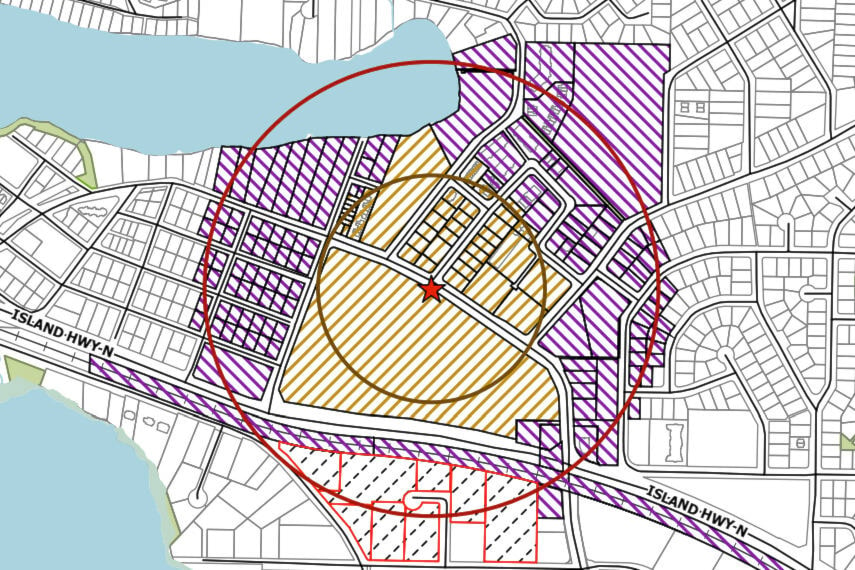New B.C. housing legislation is adding density throughout cities, but esepecially around transit exchanges.
City of Nanaimo staff, at a governance and priorities meeting Monday, March 25, provided councillors with an overview of new provincial laws establishing transit-oriented areas for high-density housing around bus exchanges. Staff was asking for approval to work on related zoning and parking amendments.
Under Bill 47, the B.C. government has identified three transit exchange sites in Nanaimo: Woodgrove Centre, Country Club Centre and Vancouver Island University. Each transit-oriented area encompasses an area within a 400-metre radius.
The legislation dictates that land parcels within a 200m radius of a transit exchange must allow up to 10 storeys at a minimum, while properties 200-400 metres away must allow up to six storeys at minimum.
Lands owned by First Nations, the federal government and lands zoned for industrial and agricultural use are exempt from Bill 47.
“The goal is to include as much diversity of housing, employment, amenities and services within a 15- to 20-minute walk of a transit exchange,” said Kasia Biegun, community planner.
Biegun said the three transit-oriented areas in Nanaimo actually fall within urban centres identified in Nanaimo’s city plan.
The legislation also tosses out residential off-street parking requirements, though minimums can be established for commercial parking, parking for people with mobility challenges, bicycles, loading zones and services. Biegun said city staff are working on understanding the implications of the parking changes and will report back to council later in the spring.
Nanaimo and other municipalities are grappling with the government’s positioning of transit-oriented areas. For example, Woodgrove’s extends into undeveloped and unserviced land parcels in Lantzville and is bisected by the Nanaimo Parkway and doesn’t align with the city plan urban centre land-use designations and policies.
It so happens the current transit exchange location is considered temporary and the Regional District of Nanaimo’s transit re-development strategy calls for a new location for the bus exchange. Biegun said work to determine a permanent bus exchange location will be complete by October and in the event the bus exchange is moved, it is staff’s understanding the transit-oriented area would also shift to reflect its new radius.
The Country Club and VIU transit-oriented areas are also in locations with mixed-use land parcels, are bisected by highways and have lands exempt from the legislation. Because two of the transit-oriented areas – Woodgrove and Country Club – have transit exchanges designated temporary locations, staff has asked the province for an extension to a June 30 deadline, but has not received a response to the request.
Coun. Hilary Eastmure asked why the government didn’t include the downtown Nanaimo transit exchange as a transit-oriented area, and Biegun said Nanaimo and other jurisdictions have asked the same question without a response. She said municipalities have been told that if more transit-oriented areas are created, there will be time allowed for city councils, city staff and members of the public to consider the implications.
“Essentially we’re going to be relying on a system of trust here,” said Nanaimo Mayor Leonard Krog. “If transit exchanges get shifted for some reason, or chosen, we’re hoping they’re going to work with us, which will enable us to respond in terms of what we allow to build there in conjunction with the laws, but otherwise we really are stumbling forward, somewhat in the dark.”
Lisa Brinkman, community planning director, said the lack of consideration for local geography has “definitely been a criticism of many of the municipalities of this provincial approach” but added that Nanaimo had fared well in the creation of TOAs compared to some municipalities.
“Just based on planning principles, it’s quite easy to understand what they’re trying to achieve. In practicality, there are some challenges,” added Jeremy Holm, director of planning and development.
Councillors recommended that council direct staff to prepare a transit-oriented area designation bylaw and amend off-street parking regulations.
READ ALSO: City of Nanaimo will be required to support housing density around bus exchanges
